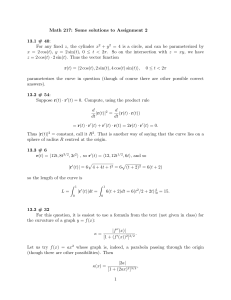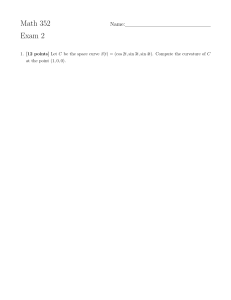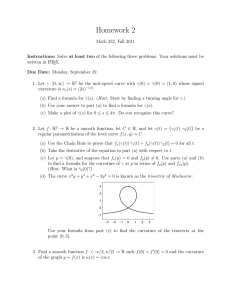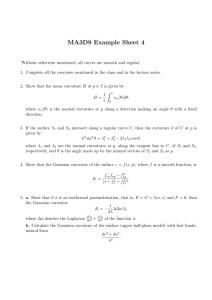Curvature and Radius of Curvature in Differential Geometry
advertisement
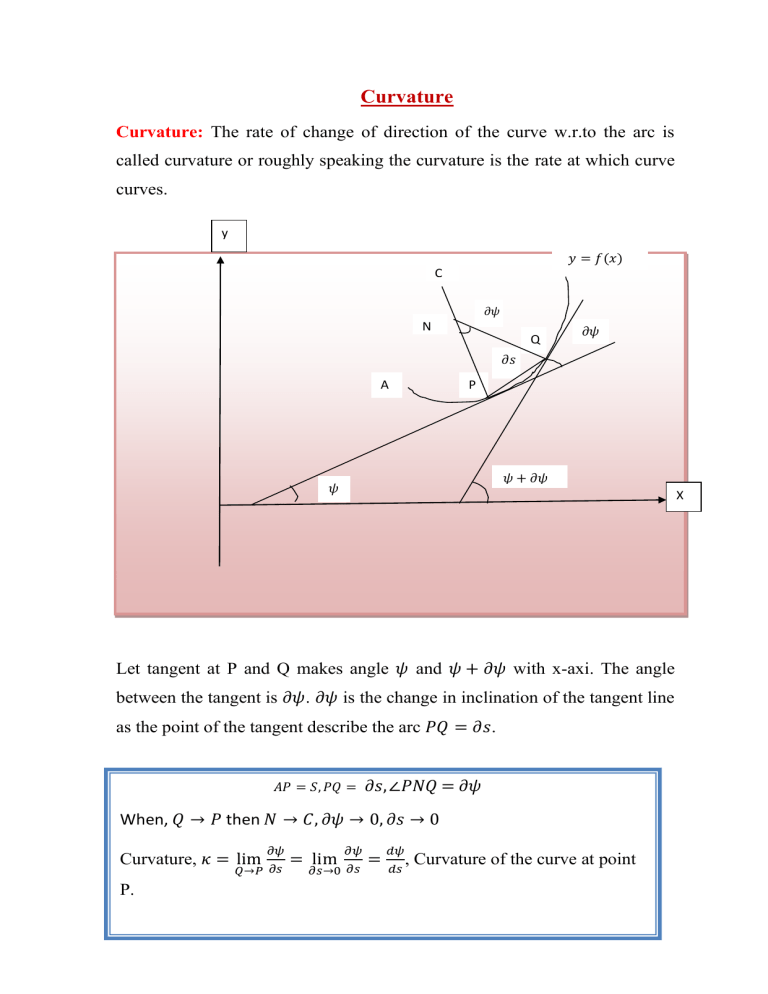
Curvature
Curvature: The rate of change of direction of the curve w.r.to the arc is
called curvature or roughly speaking the curvature is the rate at which curve
curves.
y
𝑦 = 𝑓(𝑥)
C
𝜕𝜓
N
Q
𝜕𝜓
𝜕𝑠
A
P
𝜓 + 𝜕𝜓
𝜓
X
Let tangent at P and Q makes angle 𝜓 and 𝜓 + 𝜕𝜓 with x-axi. The angle
between the tangent is 𝜕𝜓. 𝜕𝜓 is the change in inclination of the tangent line
as the point of the tangent describe the arc 𝑃𝑄 = 𝜕𝑠.
𝐴𝑃 = 𝑆, 𝑃𝑄 =
𝜕𝑠, ∠𝑃𝑁𝑄 = 𝜕𝜓
When, 𝑄 → 𝑃 then 𝑁 → 𝐶, 𝜕𝜓 → 0, 𝜕𝑠 → 0
Curvature, 𝜅 = lim
𝜕𝜓
𝑄→𝑃 𝜕𝑠
P.
= lim
𝜕𝜓
𝜕𝑠→0 𝜕𝑠
=
𝑑𝜓
𝑑𝑠
, Curvature of the curve at point
The average curvature of PQ is the ratio of 𝜕𝜓 and 𝜕𝑠.
i.e. the ratio of angle and arc length.
Avg curvature, 𝜅 = lim
𝜕𝜓
𝑄→𝑃 𝜕𝑠
= lim
𝜕𝜓
𝜕𝑠→0 𝜕𝑠
=
𝑑𝜓
𝑑𝑠
Radius of Curvature: The reciprocal of curvature at any point (P) of the
curve is called radius of curvature, denoted by 𝜌.
1
𝑑𝑠
𝜅
𝑑𝜓
I.e 𝜌 = =
G
C
P
P
X
T
If a length PC equal to 𝜌 is measured from P along the positive direction of
the normal, the point C is called the centre of curvature at P, and the circle
with centre C and radius CP (i.e. 𝜌) is called the circle of curvature at P.
Any chord of this circle through the point of contact (P) is called a chord of
curvature.
Geometrical Interpretation of Radius of Curvature:
y
𝑦 = 𝑓(𝑥)
C
𝜕𝜓
N
Q
𝜕𝜓
𝜕𝑠
A
P
𝜓 + 𝜕𝜓
𝜓
In △ 𝑃𝑁𝑄,
𝑃𝑁
𝐴𝑟𝑐 𝑃𝑄
⇒ 𝑃𝑁 = 𝐴𝑟𝑐𝑃𝑄 ∙
=
𝐴𝑟𝑐 𝑃𝑞
𝜕𝑠
∙
𝜕𝑠
∙
=
X
sin 𝑃𝑄𝑁
[
𝑃𝑁
sin 𝑃𝑁𝑄 sin 𝑃𝑄𝑁
=
𝑃𝑄
sin 𝑃𝑁𝑄
= 𝑄𝑁(𝑂𝑝𝑝𝑜𝑠𝑖𝑡𝑒)]
sin 𝑃𝑄𝑁
sin 𝑃𝑁𝑄
𝜕𝜓
𝜕𝜓 sin 𝜕𝜓
∙ sin 𝑃𝑄𝑁
𝐴𝑟𝑐 𝑃𝑞 𝜕𝑠
𝜕𝜓
∙
∙
∙ sin 𝑃𝑄𝑁
𝜕𝑆→0
𝜕𝑠
𝜕𝜓 sin 𝜕𝜓
⇒ lim 𝑃𝑁 = lim
𝜕𝑆→0
𝐴𝑟𝑐 𝑃𝑞 𝜕𝑠
𝜕𝜓
∙
∙
∙ sin 𝑃𝑄𝑁
𝜕𝑆→0 𝐴𝑟𝑐 𝑃𝑞 𝜕𝜓 sin 𝜕𝜓
= lim
When, 𝑄 → 𝑃, 𝜕𝑠 → 0, 𝜕𝜓 → 0, ∠𝑃𝑄𝑁 =
𝜋
2
∴ 𝜌 =1∙
𝑑𝑠
∙1∙1
𝑑𝜓
∴𝜌=
𝑑𝑠
𝑑𝜓
Note: The limiting position of N as 𝑄 → 𝑃 is C, then PC is called radius of
curvature at P. If 𝜌 is this radius of curvature at P then, 𝜌 = lim 𝑃𝑁.
𝜕𝑠→0
Formula (derivation) for Radius of Curvature:
Radius of Curvature for Explicit function:
For the Cartesian equation 𝑦 = 𝑓(𝑥)
ds
dy
We know,
𝑑𝑦
= tan 𝜓
𝑑𝑥
dx
Diff. w.r.to x,
𝑑2𝑦
𝑑𝑥 2
= sec 2 𝜓
= sec 2 𝜓
𝑑𝜓
𝑑𝑠
∙
𝑑𝜓
𝑑𝑥
𝑑𝑠
𝑑𝑥
1
= sec 2 𝜓 . sec 𝜓
𝜌
⇒
𝑑2𝑦
𝑑𝑥 2
⇒𝜌=
= sec 3 𝜓 ∙
sec3𝜓
𝑑2 𝑦
𝑑𝑥2
3
=
(sec2 𝜓)2
𝑑2 𝑦
𝑑𝑥2
3
=
(1+𝑡𝑎𝑛2 𝜓)2
𝑑2 𝑦
𝑑𝑥2
1
𝜌
[
𝑑𝑥
𝑑𝑠
= cos 𝜓 , 𝜌 =
𝑑𝑠
𝑑𝜓
]
3
2 2
{(1 + (
=
𝑑𝑦
) ) }
𝑑𝑥
𝑑2𝑦
𝑑𝑥 2
3
{1 + 𝑦12 }2
=
, 𝑤ℎ𝑒𝑟𝑒 𝑦2 ≠ 0
𝑦2
For the equation of the curve, 𝑥
= 𝜑(𝑦), 𝜌 =
3
2
{1+𝑥1 }2
𝑥2
𝑤ℎ𝑒𝑟𝑒 𝑥2 ≠ 0
Radius of curvature for Implicit function:
For the implicit function, 𝑓(𝑥, 𝑦) = 0
Differentiating w.r.to x,
⇒ 𝑓𝑥 + 𝑓𝑦
⇒
𝑑𝑦
𝑑𝑥
𝑑𝑦
𝑑𝑥
𝜕𝑓
𝜕𝑥
∙
𝜕𝑥
𝜕𝑥
+
𝜕𝑓
𝜕𝑦
∙
𝜕𝑦
𝜕𝑥
=0
= 0…………………………………….(1)
𝑓
= − 𝑥 ……………………………………………..(2)
𝑓𝑦
Diff (1) w.r.to x, where 𝑓𝑥 , 𝑓𝑦 are function of x and y
𝜕𝑓𝑦 𝜕𝑓𝑦 𝑑𝑦 𝑑𝑦
𝜕𝑓𝑥 𝜕𝑓𝑦 𝑑𝑦
𝑑2𝑦
+
∙
+(
+
∙ )
+ 𝑓𝑦 2 = 0
𝜕𝑥
𝜕𝑦 𝑑𝑥
𝜕𝑥
𝜕𝑦 𝑑𝑥 𝑑𝑥
𝑑𝑥
{𝑓𝑥𝑥 𝑓𝑦2 − 2𝑓𝑥𝑦 𝑓𝑥 𝑓𝑦 + 𝑓𝑦𝑦 𝑓𝑥2 }
𝑑2𝑦
∴ 2=−
𝑑𝑥
𝑓𝑦3
3
We know, 𝜌 =
{1+𝑦12 }2
𝑦2
=
3
2
𝑓2
(1+ 2𝑥 )
𝑓𝑦
2
{𝑓𝑥𝑥 𝑓2
𝑦 −2𝑓𝑥𝑦 𝑓𝑥 𝑓𝑦+𝑓𝑦𝑦 𝑓𝑥 }
𝑓3
𝑦
3
∴𝜌=
(𝑓𝑥2 +𝑓𝑦2 )2
𝑓𝑥𝑥 𝑓𝑦2 −2𝑓𝑥𝑦 𝑓𝑥 𝑓𝑦 +𝑓𝑦𝑦 𝑓𝑥2
Where, 𝑓𝑥𝑥 𝑓𝑦2 − 2𝑓𝑥𝑦 𝑓𝑥 𝑓𝑦 + 𝑓𝑦𝑦 𝑓𝑥2 ≠ 0
For Polar equation:
For the polar equation, 𝑟 = 𝑓(𝜃), 𝑟1 =
𝑑𝑟
𝑑𝜃
3
2 )2
+ 𝑟1
2𝑟12 − 𝑟𝑟2
2
𝜌=
(𝑟
𝑟2 +
Radius of curvature equation in Parametric form:
If x and y co-ordinates of any curve be expressed by third variable, then the
third variable is called parameter.
The equation with parameter is called parametric equation.
𝑥 = 𝑓(𝑡), 𝑦 = 𝑓(𝑡)
3
Then, 𝜌 =
{(𝑥′)2 +(𝑦′)2 }2
𝑥 ′ 𝑦 ′′ −𝑦′𝑥′′
, 𝑥′ =
𝑑𝑥
𝑑𝑡
, 𝑦′ =
Radius of curvature in polar form:
𝑟 = 𝑓(𝜃 ), 𝑥 = 𝑟 cos 𝜃 , 𝑦 = 𝑟 sin 𝜃
3
(𝑟 2 + 𝑟12 )2
𝜌= 2
𝑟 + 2𝑟12 − 𝑟𝑟2
𝑑𝑦
𝑑𝑡
Pedal equation:
tangent
𝑦 = 𝑓(𝑥)
r =radius vector
Center
P
0
P=Perpendicular distance
Then the relation between r and P is called pedal equation.
If 𝑃 = 𝑓(𝑟)
𝑑𝑟
𝜌=𝑟
𝑑𝑝
Derivation:
We know, 𝑃 = 𝑟 sin 𝜙
Differentiating w.r.to r,
𝑑𝑃
𝑑𝑟
= sin 𝜙 + 𝑟 cos 𝜙
=𝑟
⇒
⇒
⇒
𝑑𝜃
𝑑𝑠
𝑑𝑃
𝑑𝑟
𝑑𝑃
𝑑𝑟
𝑑𝑃
𝑑𝑟
+𝑟
=𝑟
=𝑟
=𝑟
𝑑𝑟
𝑑𝑠 𝑑𝑟
+𝑟
𝑑𝑠
𝑑
𝑑𝑠
𝑑𝑠
=
𝑑𝜃
𝑑𝑠
𝑑𝑟
𝑑𝑠
𝑟
𝑑𝑟
, 𝜃 = 𝑣𝑒𝑐𝑡𝑜𝑟𝑖𝑎𝑙 𝑎𝑛𝑔𝑙𝑒
, 𝜓 = 𝑎𝑛𝑔𝑙𝑒 𝑏𝑒𝑡𝑤𝑒𝑒𝑛 𝑡𝑎𝑛𝑔𝑒𝑛𝑡 𝑎𝑛𝑑 𝑟𝑎𝑑𝑖𝑢𝑠 𝑣𝑒𝑐𝑡𝑜𝑟
⇒ sin 𝜙 = 𝑟
𝑑𝜙
𝑑𝑠
(𝜃 + 𝜙)
𝑑𝜓
𝑑𝜃
𝑑𝜙
𝑑𝑟 𝑑𝜙
𝑑𝜃
∴ tan 𝜙 = 𝑟
[𝜓 = 𝜃 + 𝜙]
cos 𝜙 =
𝑑𝑟
𝑑𝑠
𝑑𝜃
𝑑𝑠
,
𝜙 = 𝑝𝑒𝑟𝑝𝑒𝑛𝑑𝑖𝑐𝑢𝑙𝑎𝑟 𝑎𝑛𝑔𝑙𝑒
⇒
𝑑𝑃
𝑑𝑟
=𝑟∙
⇒𝜌=𝑟∙
1
𝜌
𝑑𝑟
𝑑𝑃
Centre of Curvature:
If 𝑦 = 𝑓(𝑥) and 𝐶(𝛼, 𝛽) is the centre of curvature and 𝜌 is the radius of
curvature, then
Centre of curvature:
𝛼=𝑥−
𝛽 =𝑦+
𝑦1 (1+𝑦12 )
𝑦2
1+𝑦12
𝑦2
And equation of circle of curvature,
(𝑥 − 𝛼)2 + (𝑦 − 𝛽)2 = 𝜌2
Example 01: Find radius of curvature to any point of the curve, 𝑦 = 𝑙𝑛 (cos 𝑥).
Solution: Given the curve, 𝑦 = ln(cos 𝑥)
Now,
𝑑𝑦
𝑑𝑥
=
1
cos 𝑥
∙ (− sin 𝑥) = − tan 𝑥
𝑑2𝑦
= −𝑠𝑒𝑐 2 𝑥
2
𝑑𝑥
3
We know, radius of curvature, 𝜌 =
{1+𝑦12 }2
𝑦2
3
{1 + (− tan 𝑥)2 }2
=
−𝑠𝑒𝑐 2 𝑥
3
(𝑠𝑒𝑐 2 )2
=
−𝑠𝑒𝑐 2 𝑥
= − sec 𝑥
R.C, 𝜌 = |−𝑠𝑒𝑐𝑥| = 𝑠𝑒𝑐𝑥
Problem 02: Find radius of curvature at (0, 2) of the ellipse
Solution: Given,
𝑥2
9
+
𝑦2
4
=1
1
1
⇒ 2𝑥 +
∙ 2𝑦𝑦 ′ = 0
9
25
2𝑥
𝑑𝑦
⇒
=− 9
2𝑦
𝑑𝑥
25
=−
25𝑥
9𝑦
𝑑𝑦
𝑑2𝑦
25 𝑦 ∙ 1 − 𝑥 𝑑𝑥
=− (
)
𝑑𝑥 2
9
𝑦2
=−
=−
25
𝑑𝑦
−
𝑥
(𝑦
)
9𝑦 2
𝑑𝑥
25
25𝑥
−
𝑥
{𝑦
(−
)}
9𝑦 2
9𝑦
25 1 25𝑥 2
=− ( +
)
9 𝑦 9𝑦 3
3
{1 + 𝑦12 }2
∴ 𝑟𝑎𝑑𝑖𝑢𝑠 𝑜𝑓 𝑐𝑢𝑟𝑣𝑎𝑡𝑢𝑟𝑒, 𝜌 =
𝑦2
𝑥2
9
+
𝑦2
4
= 1.
3
2 2
{1 + (−
=
−
25𝑥
}
9 )
25 1 25𝑥 2
+
9 (𝑦 9𝑦 3 )
3
𝜌=
At, (0,5),
So, 𝜌 = |−
9
25
{1+0}2
25 1
− 9 (5+0)
|=
=−
9
25
9
25
Problem 03: Prove that the radius of curvature of the ellipse
𝑦2
𝑥2
𝑎2
+
= 1, at an end of major axes is half of its latus rectum.
𝑏2
Solution: Given ellipse,
𝑥2
𝑎2
+
𝑦2
𝑏2
= 1……..(1)
𝑦′ = −
2𝑥𝑏 2
𝑎2 𝑦
The point of major axes of equation (1) is (a,
0)and (-a, 0) and latus rectum is
2𝑏2
𝑎
.
Differentiating (1) w.r.to y (since (a, 0), 𝑦1 =
∞)
∴
-a
2𝑥𝑥1
⇒
𝑎2
𝑥𝑥1
𝑎2
+
+
2𝑦
𝑦
𝑏2
⇒ 𝑥1 = −
=−
𝑎2
𝑏2
∙
=0
𝑏2
= 0 , 𝑥1 =
𝑦
𝑎2
𝑏
𝑥
∙
2
𝑑𝑥
𝑑𝑦
𝑦
𝑥
In (a, o), 𝑥1 = −
𝑎2
𝑏2
0
∙ =0
𝑎
a
𝑥2 = −
Again,
−
𝑎2 𝑥 2 𝑏2 +𝑎2 𝑦 2
𝑏2
{
𝑏2 𝑥 3
== −
=−
𝑎2 𝑎2 𝑏2
[
𝑏2 𝑏2 𝑥 3
𝑎2 𝑥.1−𝑦.𝑥1
𝑏2
[
𝑥2
𝑎2 𝑦
]=
𝑎2 𝑥−𝑦(−𝑏2 ∙ 𝑥)
− 2{
}
𝑏
𝑥2
𝑎2 𝑦2
=
𝑎2 𝑥+ 2
− 2 [ 𝑏2 𝑥 ]
𝑏
𝑥
=
}
] from (1)
𝑎4
𝑏2 𝑥 3
In (a, 0), 𝑥2 = −
𝑎4
𝑏2 𝑥 3
=−
𝑎
𝑏2
3
∴ R.C, 𝜌 =
∴, 𝜌 = |−
(1+𝑥12 )2
𝑏2
|
𝑎
𝑥2
=
3
=
(1+0)2
𝑎
− 2
𝑏
=−
𝑏2
𝑎
𝑏2
𝑎
Which is the half of its latus rectum.
𝑏2
Similarly, in (-a, 0) radius of curvature is | |.
𝑎
Problem 04: Find radius of curvature at 𝜃 = 0 of, 𝑥 = 𝑎(𝜃 + sin 𝜃 ),
𝑦 = 𝑎(1 − cos 𝜃 ).
Solution: Given the equation,
𝑥 = 𝑎(𝜃 + sin 𝜃 )
𝑦 = 𝑎(1 − cos 𝜃 )
𝑥1 =
𝑥2 =
𝑑𝑥
𝑑𝜃
= 𝑎 + 𝑎 cos 𝜃, 𝑦1 = 𝑎 sin 𝜃
𝑑2 𝑥
𝑑𝜃 2
= −𝑎 sin 𝜃, 𝑦2 = 𝑎 cos 𝜃
R.C at 𝜃 = 0,
𝑥1 = 𝑎 + 𝑎 cos 0 = 2𝑎, 𝑦1 = 𝑎 sin 0 = 0
𝑥2 = −𝑎 sin 0 = 0, 𝑦2 = 𝑎 cos 0 = 𝑎
R.C at 𝜃 = 0,
3
𝜌=
=
{(𝑥′)2 +(𝑦′)2 }2
𝑥 ′ 𝑦 ′′ −𝑦′𝑥′′
)2
{(2𝑎
3
2 2
+(0) }
2𝑎×𝑎−0×0
3
=
(4𝑎2 )2
2𝑎2
= 4𝑎
Hence, radius of curvature at 𝜃 = 0, 𝑖𝑠 4𝑎.
Problem 05: Find R.C 𝑟 = 𝑎(𝜃 + sin 𝜃), 𝑎𝑡 𝜃 = 0.
Solution: Given the equation, 𝑟 = 𝑎(𝜃 + sin 𝜃)
𝑟1 =
𝑑𝑟
= 𝑎(1 + cos 𝜃)
𝑑𝜃
𝑑2𝑟
𝑟2 = 2 = 𝑎(− sin 𝜃) = −𝑎 sin 𝜃
𝑑𝜃
At 𝜃 = 0,
𝑟1 = 𝑎(1 + cos 0) = 2𝑎
𝑟2 = 𝑎(− sin 0) = 0
𝑟 = 𝑎(0 + sin 0) = 0
3
2
(𝑟2 +𝑟2
)
1
𝑟2 +2𝑟21 −𝑟𝑟2
∴ R.C , 𝜌 =
3
2 2
=
{0+(2𝑎) }
2
0+2.(2𝑎) −0
=𝑎
Problem 06: Find circle of curvature at (0, 1) of the curve = 𝑥 3 +
2𝑥 2 + 𝑥 + 1 .
Solution: Given equation, = 𝑥 3 + 2𝑥 2 + 𝑥 + 1 .
Differentiating (1) w.r.to x,
𝑦1 = 3𝑥 2 + 4𝑥 + 1
And again, 𝑦2 = 6𝑥 + 4
At (0,1), 𝑦1 = 1, 𝑦2 = 4
3
∴ R.C at (0,1), 𝜌 =
{1+𝑦21 }2
𝑦2
3
=
(1+1)2
4
=
∴ centre of curvature, (𝛼, 𝛽 ) at (0,1)
𝛼 =0−
𝛽 =1+
𝑦1 (1+𝑦12 )
𝑦2
1+𝑦12
𝑦2
=0−
=1+
1+1
4
1(1+1)
4
=
=−
1
2
3
2
Hence, the circle of curvature at (0,1)
1 2
3 2
1
(𝑥 + 2) + (𝑦 − 2) = ( 2)
2
√
1
9
1
4
4
2
⇒ 𝑥 2 + 𝑥 + + 𝑦 2 − 3𝑦 + =
2√2
4
=
1
√2
Home work:
2
3
2
3
2
3
1. Find R.C of the asteroid 𝑥 + 𝑦 = 𝑎 at any point.
2. Find R.C. of 𝑦 = 𝑥 4 − 4𝑥 3 − 20𝑥 2 at the origin.
3. Find R.C. at (a,0) of the ellipse, 𝑥 = 𝑎 cos 𝜃, 𝑦 = 𝑏 sin 𝜃.
4. Find R.C at (a,0) of the curve 𝑟 = 𝑎𝑠𝑒𝑐𝜃.

